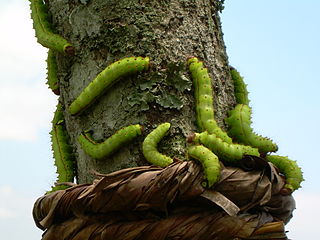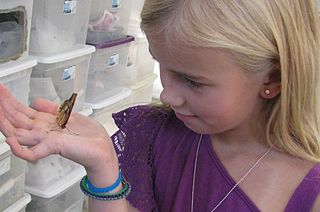Related Research Articles

The domestic silk moth is an insect from the moth family Bombycidae. It is the closest relative of Bombyx mandarina, the wild silk moth. The silkworm is the larva of a silk moth. The silkworm is of particular economic value, being a primary producer of silk. A silkworm's preferred food are white mulberry leaves, though they may eat other species of mulberry, and even leaves of other plants like the osage orange. Domestic silk moths are entirely dependent on humans for reproduction, as a result of millennia of selective breeding. Wild silk moths are not as commercially viable in the production of silk.

In seed plants, the ovule is the structure that gives rise to and contains the female reproductive cells. It consists of three parts: the integument, forming its outer layer, the nucellus, and the female gametophyte in its center. The female gametophyte — specifically termed a megagametophyte— is also called the embryo sac in angiosperms. The megagametophyte produces an egg cell for the purpose of fertilization. The ovule is a small structure present in the ovary. It is attached to the placenta by a stalk called a funicle. The funicle provides nourishment to the ovule.
The chalaza is a structure inside bird eggs and plant ovules. It attaches or suspends the yolk or nucellus within the larger structure.

Bombykol is a pheromone released by the female silkworm moth to attract mates. It is also the sex pheromone in the wild silk moth. Discovered by Adolf Butenandt in 1959, it was the first pheromone to be characterized chemically.

Bombyx is the genus of true silk moths or mulberry silk moths of the family Bombycidae, also known as silkworms, which are the larvae or caterpillars of silk moths. The genus was erected as a subgenus by Carl Linnaeus in his 10th edition of Systema Naturae (1758).

The Silkworm is a 2014 crime fiction novel written by J. K. Rowling, and published under the pseudonym Robert Galbraith. It is the second novel in the Cormoran Strike series of detective novels and was followed by Career of Evil in 2015, Lethal White in 2018,Troubled Blood in 2020 and The Ink Black Heart in 2022.

The Bombycidae are a family of moths. The best-known species is Bombyx mori (Linnaeus), or silkworm, native to northern China and domesticated for millennia. Another well-known species is Bombyx mandarina, also native to Asia.

Bombyx mandarina, the wild silk moth, is an insect from the moth family Bombycidae. It is the closest relative of Bombyx mori, the domesticated silk moth. The silkworm is the larva or caterpillar of a silk moth. Unlike the domesticated relative which is unable to fly or indeed persist outside human care, the wild silk moth is a fairly ordinary lepidopteran. Its main difference from the domesticated taxon is the more slender body with well-developed wings in males, and the dull greyish-brown colour.
Micropyle may refer to:

Mandarina is a genus of air-breathing land snail, a terrestrial pulmonate gastropod mollusk in the family Bradybaenidae.

Wild silks have been known and used in many countries from early times, although the scale of production is far smaller than that from cultivated silkworms. Silk cocoons and nests often resemble paper or cloth, and their use has arisen independently in many societies.
Opinion 2027 is a 2003 ruling of the International Commission on Zoological Nomenclature (ICZN) concerning the conservation of 17 species names of wild animals with domestic derivatives. Opinion 2027 is in response to Case 3010 and subsequent comments.

Antheraea pernyi, the Chinese (oak) tussar moth, Chinese tasar moth or temperate tussar moth, is a large moth in the family Saturniidae. The species was first described by Félix Édouard Guérin-Méneville in 1855. Antheraea roylei is an extremely close relative, and the present species might actually have evolved from ancestral A. roylei by chromosome rearrangement.
The Bombyx hybrid is a hybrid between a male Bombyx mandarina moth and a female Bombyx mori moth. They produce larvae called silkworms, like all species of Bombyx. The larvae look a lot like the other variations. They are brown in the first half and gray at the bottom half, but they get larger black spots than other variations. Generally, they look like a normal Bombyx moth, but a bit darker. Hybrids are not used for silk, but for research. Because Bombyx mori males lost their ability to fly, their females are much more likely to mate with a male Bombyx mandarina. The reverse is possible, but both species have to be kept in the same container. Since Bombyx hybrids are much more common than the other variation, more is known about them.
The Bombyx second hybrid is a cross between a male Bombyx mori moth and a female Bombyx mandarina moth. Since the male Bombyx mori does not fly, it is completely dependent on humans to reproduce. They produce larvae called silkworms, like all species in Bombyx, except they are brownish in the first half and grayish at the bottom half. They produce silk and give out black droppings.

Commercial butterfly breeding or captive butterfly breeding is the practice of breeding butterflies and moths in controlled environments to supply the stock to research facilities, universities, zoos, insectariums, elementary and secondary schools, butterfly exhibits, conservation organizations, nature centers, individuals, and other commercial facilities. Some butterfly and moth breeders limit their market to wholesale customers while other breeders supply smaller volumes of stock as a retail activity. Some small scale and larger scale breeders limit their businesses to the provision of butterflies or moths for schools. Others provide butterflies to be used and released in commemorative events. The release usually occurs in the natural range of the butterfly.
Boris Lvovich Astaurov was a Soviet and Russian biologist and geneticist who worked on breeding experiments including pioneering work on silkworms, in which he demonstrated the induction of parthenogenesis, polyploidy, and cloning. He produced fertile tetraploid hybrids of the silkworm species Bombyx mori and Bombyxmandarina. Astaurov was among the few Mendelian geneticists who survived Stalin's purge.
Antheraea roylei is a large moth in the family Saturniidae occurring in Nepal, Thailand, Burma, Vietnam, West Malaysia, and the Himalayan regions of India. The species is considered to be the wild progenitor of the domesticated species known as Antheraea pernyi; the theory is that pernyi may have evolved from ancestral A. roylei by chromosome rearrangement during domestication.

Mandarina is the fourteenth studio album by Peruvian singer-songwriter Gian Marco released by Enjoymusic Plubishing on May 28, 2021, as his first release in 3 years. The album includes 11 tracks including collaborations with Argentinian artists Coti and Diego Torres as well as with Spanish singer Rozalén.
References
- ↑ Kawaguchi, Yutaka (1996). "Comparison of Chorion Structure of Eggs from Bombyx mori, Bombyx mandarina (Lepidoptera:Bombycidae) and Their First Filial Generation". Applied Entomology and Zoology. 31 (3): 407–415. doi: 10.1303/aez.31.407 .